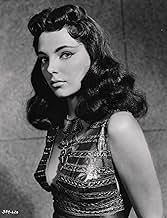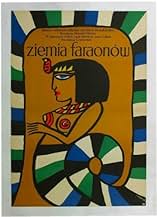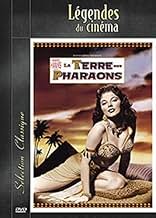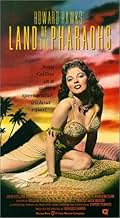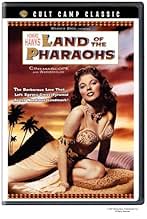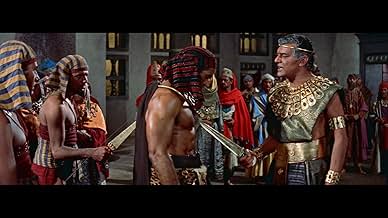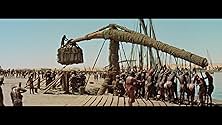Ein gefangener Architekt entwirft einen genialen Plan, um die Uneinnehmbarkeit des Grabes eines egozentrischen Pharaos zu gewährleisten, der von der Sicherheit seines nächsten Lebens besesse... Alles lesenEin gefangener Architekt entwirft einen genialen Plan, um die Uneinnehmbarkeit des Grabes eines egozentrischen Pharaos zu gewährleisten, der von der Sicherheit seines nächsten Lebens besessen ist.Ein gefangener Architekt entwirft einen genialen Plan, um die Uneinnehmbarkeit des Grabes eines egozentrischen Pharaos zu gewährleisten, der von der Sicherheit seines nächsten Lebens besessen ist.
- Regie
- Drehbuch
- Hauptbesetzung
- Kyra
- (as Luisa Boni)
- Egyptian Architect
- (Nicht genannt)
- Captain of the Guard
- (Nicht genannt)
- Dancer at the Party
- (Nicht genannt)
- Priest
- (Nicht genannt)
- Nabuna, Nellifer's Bodyguard
- (Nicht genannt)
- Bit Part
- (Nicht genannt)
- Mea
- (Nicht genannt)
- Dancer at the Party
- (Nicht genannt)
Empfohlene Bewertungen
As a grand epic from the era where they made them big and were not afraid to spend money where it would show up on screen, "Land of the Pharaohs" surpasses many other epics of its period and even many recent films dealing with a similar subject (1999's "The Mummy" comes to mind). "Pharaohs" has an impressive and very satisfying climax that makes perfect sense historically and dramatically.
Also, no one seems to have mentioned the marvelous handling of crowds, particularly in the lengthy building of the pyramid sequence. I'll even go so far as to say the way Hawks composes his crowds for the cinemascope screen - arranging his Egyptian workers and pharaoh worshipers in intricate patterns with complex movements - rivals even Fritz Lang's similar work in "Metropolis" (1926), famous for its handling of crowds.
I think one of the reasons the film keeps getting bashed is because people haven't seen it in its original widescreen format in many years. Until recently, no Region 1 DVD has been available, so in its cropped, pan and scan VHS incarnation, the film comes across as wimpy and ridiculous. As can be seen in the widescreen DVD release, the grandeur is stunning, its art direction, costumes, sets and locations all holding up marvelously.
It must be said that composer Dimitri Tiomkin probably never wrote a score as majestically spirited as this one, a vast canvas of antiquity and drama. The cast is very much of its time, and some of the dialog is stilted and dated, but with the passing of time, most films suffer from this. Time passes and acting styles change. But a good plot holds up, and "Pharaohs" has plenty of the devious vs altruistic characters that drove many of Hawks plots effectively.
The powers that be in Hollywood finally released the film on DVD, promoting it as a camp classic, adorning the cover with a cheesy shot of Joan Collins, the one thing they apparently consider notable and sell-able about the film. Too bad. Yes, "Land of the Pharaohs" does have an element of campiness, but there is true grandeur in the vastness of the production and the fact that its cast of thousands was indeed a cast of thousands, not CGI. Perhaps one day the wonders of this film will be given the appreciation it deserves. As time passes these epics seem to be acquiring as much antiquity as the genuine historical period itself.
Jack Hawkins plays an Egyptian pharaoh named Khufu, who wants to be extremely prepared for his "second" life. He desires the perfect pyramid to be built to house his body and his plethora of treasures obtained from war. He learns that one of his current prisoners, Vashtar (James Robertson Justice), is an experienced architect, and indeed Vashtar comes up with some ingenious ideas for crafting an impregnable fortress. Meanwhile, Khufu obtains himself wife # 2, a young princess named Nellifer (Joan Collins). And she's a greedy and conniving person who stops at nothing to get what she wants.
"Land of the Pharaohs" may be a challenge for some people to take seriously, but technically it really is well made, and it's consistently entertaining. Also in the cast are Dewey Martin as Vashtars' son Senta, Alexis Minotis as Khufu's loyal high priest Hamar, Sydney Chaplin as the traitorous Treneh, and James Hayter as Vashtars' friend Mikka. These people all do the very best that they can, but it's the ravishing young Collins who tends to steal the show - and whom the audience is likely to remember the most.
Among the heaviest assets that this can boast are Dimitri Tiomkins' rousing music score, the cinematography by Lee Garmes & Russell Harlan, the art direction by Alexandre Trauner. and the various costumes (especially those worn by Collins). Viewers may also get a big kick out of the fairly grim twist ending.
Seven out of 10.
"Land of the Pharaohs" (1955) is a sword & sandal epic that doesn't overstay its welcome at well under 2 hours. It was director Howard Hawk's first box office failure and so he took four years off from filmmaking to tour Europe before returning with the hit Western "Rio Bravo" (1959). It has since become a cult film and Martin Scorsese admitted that it is one of his favorites.
The subject is fascinating. The Pyramid of Khufu is the oldest of the Seven Wonders of the Ancient World and the only one to remain relatively intact. It is estimated to have taken almost three decades to build. There are several theories of its planning & construction and the movie brings this to life for the viewer. The Egyptian government supplied 3000-10,000 extras for the 50-plus day shoot, half of them soldiers. While Jack Hawkins and the actor who plays Vashtar look decidedly European as opposed to anyone from the ancient Egypt region, producers wisely darkened Joan's skin and her potential lover looks serviceably Egyptian.
Although critics decry the subplot in the second half concerning an assassination conspiracy, there's plenty to enjoy in this lush spectacle: cowards thrown to crocodiles, the curious beliefs behind building such a unique colossal structure, the obsession & perseverance it took to see it through, thousands of extras, real vessels in the river, authentic locations, recreations of hauling the 2.5 ton stones, the Pharaoh taking on a bull, death traps, athletic dancing, Joan's youthful beauty, a quality sword fight to the death, the tragic close and Dimitri Tiomkin's great score.
Lastly, the flick inspires one to look up the actual pyramid, its history and videos of its exterior and innards. It might even inspire you to see it firsthand.
The film runs 1 hour, 46 minutes, and was shot in Egypt with studio stuff done in Rome.
GRADE: B.
Over the years, many have criticized the film, including Howard Hawks, Hawkins and Collins. On close examination, their criticism of the dialogue is only partially justified. While there is some verbosity, and the discourse between Khufu and his first wife over his desire for a son seems unnecessary if not ridiculous(in this instance actions would speak louder than words)the dialogue is more than serviceable. During the funeral ritual for the heroic dead, the grand, evocative speech is even inspired.
Hawks also lamented that the film contained "no one to root for." Indeed, Hawkins' Pharaoh is decisive, infrequently warm and unquenchably greedy. As Princess Nellifer, Joan Collins is even more unsavory. There exists however, a necessary counterpoint in the character of Vashtar, who designs the pyramid in order to free his people. James Robertson Justice gives a sympathetic performance as the designer who is alternately good natured, thoughtful, and indignant at the pharaoh's cruelty. As the pharaohs advisor, Alexis Minotis manages a remarkable acting feat by enforcing Khufu's will and simultaneously evoking audience sympathy. As Vashtar's son, Dewey Martin's All-American boy persona is the only off key note.
Despite the generally capable acting, the film's chief attraction is the abundant spectacle. The thousands of workers toiling to build the pyramid, and the colorful court pageantry, are what linger most in the viewer's mind. The much-discussed ending may or may not be historically accurate, but is nevertheless filmed with a chilling sense of realism. In short, Land of the Pharaohs is an interesting thematic departure from the epics of the 1950s.
Wusstest du schon
- WissenswertesThe movie was Producer and Director Howard Hawks' first commercial failure. It caused him to take a break from directing and travel through Europe for a few years. His next movie, Rio Bravo (1959), was the longest break between two movies in his career.
- PatzerDomesticated camels feature throughout the film, which is set in the early Old Kingdom. But the camel was not domesticated around Egypt until the end of the New Kingdom, some two thousand years later.
- Zitate
Hamar: You must give the order, your Majesty.
Princess Nellifer: The order is given.
[a priest walks around the pharaoh's sarcophagus breaking the clay pots which will release the sand and set the sealing of the pyramid in motion]
Hamar: It is done, your Majesty.
Princess Nellifer: Then I Nellifer am now Queen of Egypt and I now order...
[she pauses listening to a distant sound]
Princess Nellifer: What is this?
Hamar: The tomb is being sealed, your Majesty.
Princess Nellifer: NO! Show me the way out! I command you; show me the way out!
Hamar: There's no way out. This is what you lied and schemed and murdered to achieve! THIS is your kingdom!
Princess Nellifer: No, no, no.
[she sobs uncontrollably]
Princess Nellifer: I don't want to die. I don't want to die. I don't want to die; Please help me!
[she collapses on the floor of the burial chamber]
- VerbindungenEdited into The Story of Mankind (1957)
Top-Auswahl
- How long is Land of the Pharaohs?Powered by Alexa
Details
Box Office
- Budget
- 2.900.000 $ (geschätzt)
- Laufzeit1 Stunde 46 Minuten
- Seitenverhältnis
- 2.55 : 1
Zu dieser Seite beitragen



